Giant baobab trees are icons of sub-Saharan Africa’s dry savannahs. Their vital statistics are impressive, they dominate the landscape and they provide resources for people and for many species of animals.

The African baobab (Adansonia digitate) is considered to be a keystone species with many mammals, birds, reptiles and insects depending on baobabs for food and shelter. The shade of the trees contributes to keeping soil humid, the trees contribute to nutrient recycling and they protect against soil erosion.
For people too, the leaves and fruits are very nutritious and more than that, all parts of the tree are used for their medicinal properties. Included among the beneficial medicinal characteristics are anti-inflammatory, anti-bacterial and anti-oxidant properties.
The bark is used for its fibre to make rope, mats, fishing nets and line, sacks and cloth. Remarkably the bark regrows so within limits it is possible to harvest the bark sustainably.
Large trees collect rainwater in clefts and hollows – providing water to travellers and local villagers – and in some instances the trunks have been hollowed out to act as reservoirs. The roots may also be tapped for water.

An African hoopoe (Upupa africana) resting in a hollow between the branches of a baobab tree
In South Africa the natural distribution of baobabs is limited to the northern part of Limpopo province, which includes the northern section of the Kruger National Park. However, I have seen a baobab tree in KwaZulu-Natal – it is a cultivated specimen that, surprisingly, is surviving adjacent to the multi-storey carpark of the Musgrave Shopping Centre in Durban!
Elsewhere in southern Africa baobabs (Adansonia digitate) occur naturally in suitable habitat in Angola, Namibia, Botswana, Zimbabwe, Malawi and Mozambique, limited to hot, dry savannah woodland on stoney, well drained soils in areas that are frost-free. Baobabs cannot survive frost or water-logged soils and they are not found in areas with deep sand.

Above is a view over woodland in the northern section of the Kruger National Park where a baobab grows on a stony ridge. The nest that is visible at the end of one of the branches is likely to be the rather messy accumulation of sticks that form the communal nests of red-billed buffalo weavers (Bubalornis niger)

This tree in Kruger National Park is known as Van Weilligh’s Baobab, named for a surveyor G.R. van Weilligh who carved his initials on the tree in 1891. Red-billed buffalo weaver communal nests can be seen at the end of one of the right-hand branches. Elephants have stripped the bark from the lower section of the main trunk
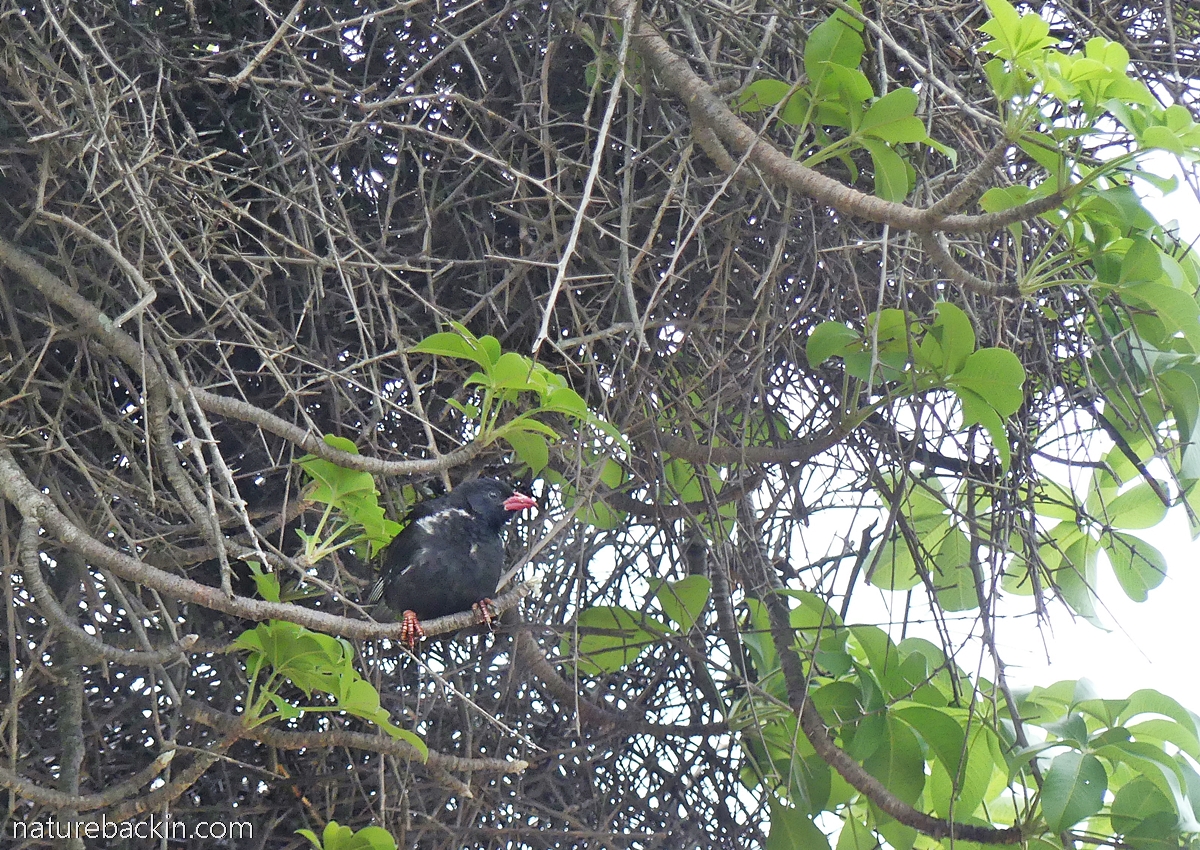
On a dull overcast morning it was difficult to get a clear photo of a dark-coloured red-billed buffalo weaver against the mess of sticks comprising the communal nest. Several birds were coming and going, returning with sticks collected to add to the nest

Also nesting in Van Weilligh’s Baobab was a pair of mosque swallows (Cecropis senegalensis). In South Africa, these swallows occur only in the north-eastern Mpumalanga and Limpopo provinces as well as occurring in regions of other southern African countries. These swallows favour tall, dense, broad-leaved woodland and are often found in association with baobab trees. Mosque swallows have long forked tails and the long tail feathers of the bird in the photo above can be seen extending beyond the long wing tips

Although mosque swallows do build nests made from mud pellets in places such as under overhangs, some pairs nest in holes in trees, especially in baobab trees. In the photo above the nesting hole underneath a large branch in Van Weilligh’s Baobab is visible. Hole-nesting mosque swallows may use mud to fill up their nesting hole to make it the desired size

Above is the second bird in the pair we saw nesting in Van Weilligh’s Baobab. I assume that it is moulting as it appears to be lacking tail feathers! Mosque swallows are recorded as moulting during October/November and this photo was taken in November
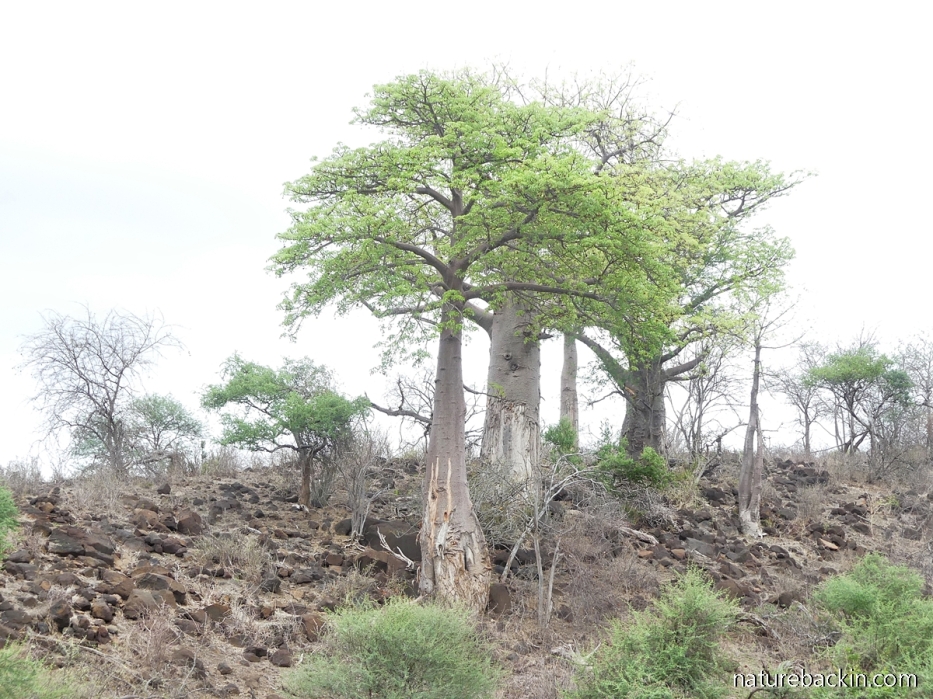
Baobab trees of varying ages on a stony ridge in the Pafuri region of the Kruger National Park
Very young baobab trees do not resemble mature trees at all. Even the leaves are different in shape, being simple unlike the palmate leaves with their six or seven digits on mature trees. Seed production begins when trees are 8–23 years old, and trees are considered to be mature around the age of about 60 years. The typical lifespan of a tree is about 450 years, although with the use of carbon-dating a few exceptional individual trees have been shown to be as old as 2000 years. African baobab trees may grow to a height of around 25 m, but it is their girth that is truly enormous. As they grow older trees produce more stems that combine into the appearance of one trunk with the diameter of larger trees being 10–14 m (33–46 ft).

Yet another African baobab where the bark has been browsed by elephants
Elephants eat the nutritious bark of several species of trees. Unusually though the baobab has the ability to regrow its bark and can survive bark stripping both by elephants and people up to a point. If the bark stripping is within limits and the tree is not subjected to other stresses such as fire or extremes of drought or water logging it can survive.

This relatively small baobab tree growing next to the road near Pafuri picnic site in the Kruger National Park was perhaps blown over in the wind with the soil being moist after recent rains. I wonder if the road will be rerouted around this tree so that it has a chance of survival?
Provided enough of the root system remains in the ground, fallen trees can continue to grow and in time start growing vertical branches at 90 degrees to the fallen tree. However, some trees affected by water logging or other adversity can rot inside and then literally disintegrate and suddenly collapse.

The above photo shows the intact bark above the areas where the bark has been stripped by elephants. The bark of baobabs is fire resistant
A further incentive for elephants to eat the bark of baobabs is the moisture that the tree contains in its trunk. Baobabs are succulent in that they contain high amounts of water in the trunk and branches, storing water from the rainy season for the tree the draw on in the dry season. In times of drought elephants are drawn to eat into the fibres of the trunk to obtain its moisture.

This tree in Kruger National Park is evidence of how far elephants can go into a tree in search of the moisture held in the trunk. Obviously this level of damage weakens the tree. In an effort to protect the tree large sharp stones have been placed around the base of the tree to deter elephants from approaching the trunk

Viewed from the other side the tree looks relatively healthy and it was flowering and producing fruit when we photographed it in November 2021

Also on the same tree, the leaf growth was advanced compared to trees in other areas, perhaps due to differing localised early summer rainfall. A woodland kingfisher (Halcyon senegalensis) spent time perching in the shade probably scanning for food. Woodland kingfishers make their nests in holes in larger trees

Red-billed buffalo weavers were busily bringing sticks to the large communal nests in the baobab tree, activity interspersed with noisy defensive and breeding displays

A female red-billed buffalo weaver displaying near a nest in response to overtures from a male

A flower and fruit on the baobab tree. The flowers are pollinated by bats as well as by some insects and birds. The flowers last only about 24 hours before turning brown and falling from the tree

A fallen flower that has turned brown and dehydrated

Fruits and flowers on another baobab tree photographed on a cloudy morning
The fruits may be round or cylindrical. The shell is very thick and hard. After ripening, the fruits fall to the ground. By then the flesh has dried out into a crumbly powder and the hard seeds remain in the intact shell. Animals such as elephants are able to crack the shells and eat the fruit. Elephants act as important seed dispersers – the seeds pass through their digestive tract and are deposited in the dung. The digestive process activates the seed and the dung provides a fertile environment for the seeds to sprout and take root. Baboons too are significant seed dispersers. Fire can also stimulate seed germination.
Fallen fruits are collected by people living in the vicinity of baobab trees. The dried pulp can be ground into a powder that is dissolved in milk or water to make a nutritious and tasty drink. The pulp can also be used as a thickening agent and as seasoning.
The seeds are edible and may be roasted, boiled, fermented or dried or ground into a powder. The seeds can be used to produce an oil which is gaining in popularity for use in personal care products for skin and hair treatments.

Increasingly there has been a commercialisation of baobab products for export. Gus Le Breton a.k.a. The African Plant Hunter argues that harvesting fallen fruits for commercial processes brings much needed income to rural communities in his native Zimbabwe in regions where subsistence agriculture is tenuous at best in drought prone areas. Realising the commercial potential of the baobab fruits not only improves the income of rural communities but also leads to the protection of baobab trees and habitats, which are of significant ecological importance. To watch Le Breton talk about the Baobab Superfruit see his video here.
Le Breton’s Zimbabwean company B’Ayoba has teamed up with Limpopo-based EcoProducts founded by Dr Sara Venter (see also Baobab Foundation) to form Baobab Exports, which claims to be ethical and sustainable with all products traceable to source. Among the benefits of their programmes they list fair incomes, environmental protection, social programmes, empowerment of women and the formation of farmer cooperatives that adhere to certified organic practices.
With so much distressing news currently, it is good to read of positive initiatives such as these.

Asogwa, Ifeyinwa Sabina, Ajibola Nihmot Ibrahimb,& Johnpaul Ifechukwu Agbakac. 2021. African baobab: Its role in enhancing nutrition, health, and the environment. Trees, Forests and People, vol. 3, March, 100043. https://www.sciencedirect.com/science/article/pii/S2666719320300431
Baobab Exports. 2018. EcoProducts B’Ayoba: Africa’s leading producers of FairWild, Organic Baobab Fruit. https://www.baobabexports.com/
Baobab Foundation. 2022. We promote & support the conservation of baobab treesand the lives of communities who live among these magnificent trees. https://baobabfoundation.co.za/
Hankey, Andrew. 2004. Adansonia digitate. S A National Biodiversity Institute (SANBI). http://www.plantzafrica.com/plantab/adansondigit.html
Le Breton, Gus. [n.d.] Baobab Superfruit – Africa’s Gift to You. The African Plant Hunter.
Wikipedia. 2022. Adansonia digitate. https://en.wikipedia.org/wiki/Adansonia_digitata#Distribution
Posted by Carol




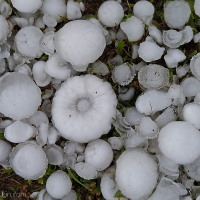


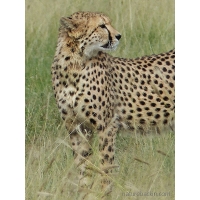
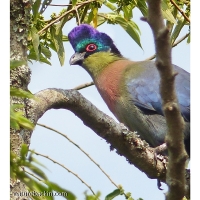
May 21, 2022 at 1:09 am
Thank you for this captivating portrait of an iconic tree.
LikeLiked by 1 person
May 21, 2022 at 2:48 pm
Thanks Tanja. As they don’t occur this far south where I live they have a certain exoticism to me too even though they are iconic of Africa.
LikeLiked by 1 person
May 11, 2022 at 4:59 am
For me the baobab was/is always a symbol for Africa. Very interesting post about an extraordinary tree!
LikeLiked by 1 person
May 15, 2022 at 8:57 am
Thanks Simone. They are extraordinary trees.
LikeLiked by 1 person
May 9, 2022 at 4:17 pm
Oh how I enjoyed this post, Carol. I love love love baobab trees, so enormous and unique, with so much to offer. I appreciated this informative post with lots of info about the baobabs that I did not know. How wonderful, for instance, that they keep growing even when they’ve fallen. Terrific photos too. That one of the elephant damage going all the way into the tree is astounding. Also really liked seeing this lovely array of birds with the baobab, especially the stunning hoopoe. When I have visited Africa the seasons were when the baobabs were without leaves, so seeing them here in leaf was also a joy.
LikeLiked by 1 person
May 15, 2022 at 8:56 am
Thanks Jet – yes we were astonished to see how far that particular tree had been eaten into by elephants and that the tree still looked healthy. Baobabs have a slightly different character when in leaf I think.
LikeLiked by 1 person
May 8, 2022 at 4:48 pm
These are magnificent trees and your post about them has done them full justice. Thank you for the fascinating information and another set of remarkable photographs
LikeLiked by 1 person
May 8, 2022 at 7:53 pm
Thanks very much Mariss. It is worth travelling further north just to see the baobabs!
LikeLike
May 8, 2022 at 10:30 am
Such an iconic tree. And so much fascinating information here, thank you! Mustn’t forget the photos either 😊
LikeLiked by 1 person
May 8, 2022 at 7:52 pm
Lovely to hear from you Sandra and thanks. There is so much to say about baobabs but much is oft repeated so I decided to build the post around the photos I had.
LikeLiked by 1 person
May 8, 2022 at 6:14 am
I’ve read of a hoepoe several times, but never looked it up. What a delightful looking bird you have there.
The detail about your baobab tree is mindblowing. Hard to imagine that a tree might survive being knocked over or hollowed out to such an extent. Thank you for introducing me to this fascinating tree. I’ve seen or heard it mentioned now or then, but did not realize what a wonder it truly is.
LikeLiked by 1 person
May 8, 2022 at 7:50 pm
Yes hoopoes are delightful. They do a lot of foraging on the ground – a treat to see them busily searching for food.
I agree – baobabs truly are a wonder.
LikeLiked by 1 person
May 8, 2022 at 2:34 am
Another fascinating post, Carol. What a resilient tree, so well adapted to its environment and so important to many species. It would be pretty cool to see elephants around one of them!
LikeLiked by 1 person
May 8, 2022 at 7:48 pm
Thanks Graham. The baobab is sometimes referred to as the elephant of trees – not only are they big but they also have tough gray bark/hide 🙂 Yes it would be wonderful to see elephants around a baobab.
LikeLiked by 1 person
May 6, 2022 at 1:32 pm
As a child, I was fascinated by illustrations of baobab trees that I had in one of my books. I still haven’t seen one ‘for real’. But nor had I realised how very versatile they are. Such an interesting post.
LikeLiked by 1 person
May 6, 2022 at 7:34 pm
Thanks Margaret. There is something almost fanciful about the baobab trees – they definitely capture the imagination.
LikeLike
May 6, 2022 at 11:39 am
What a great post, with lots of interesting facts. They are such amazing trees! As I was reading a memory was triggered of eating the fruit when I was a young girl was triggered!
LikeLiked by 1 person
May 6, 2022 at 12:06 pm
(Sorry! I hit ‘reply’ by mistake while I was editing my comment 🙄) I was fascinated that a fallen tree can regrow, and I’m wondering too whether the road will be diverted around the fallen tree. The elephant damage to the one tree you photographed is huge. The Mosque Swallows are extremely pretty little birds, and I found it interesting reading that they nested in the trees. Your photos of the trees are gorgeous.
LikeLiked by 1 person
May 6, 2022 at 7:33 pm
Years ago we visited the famous Baines Baobabs in Botswana and one of the very large trees had tipped up and was still growing. So long as a sufficient section of the roots remain intact in the ground it seems they can survive tipping up. Possibly the succulent trunk keeps the tree going while the roots adjust.
Yes that elephant damage was severe and it seemed remarkable that the tree withstood it – perhaps it is partly due to the fact that the trunk in larger trees is actually made up of several stems.
The mosque swallows are lovely – I had not seen them before.
LikeLiked by 1 person
May 6, 2022 at 7:26 pm
Thanks Megan, They are remarkable trees. How interesting that you remembered eating the fruit when you were a girl. I hope that you remember it as a pleasant-tasting fruit. I have not tasted it.
LikeLiked by 1 person
May 6, 2022 at 11:20 pm
I remember the taste being refreshing!
LikeLiked by 1 person
May 8, 2022 at 7:45 pm
Sounds good!
LikeLiked by 1 person
May 6, 2022 at 8:34 am
Such a lovely post Carol! Full of interesting information and excellent photos to illustrate, thank you, xxx
LikeLiked by 1 person
May 6, 2022 at 8:00 pm
Thanks Christeen. It was hard to decide what to include as they are such interesting trees!
LikeLiked by 1 person
May 6, 2022 at 5:26 am
Another terrific essay on an iconic piece of Africana, Carol.
Baobabs are, in one word, magnificent! Natural monuments and landmarks used for ages.
We’re hoping to visit Mapungubwe National Park during next month’s school holidays and, like northern Kruger, it boasts beautiful Baobab specimens.
LikeLiked by 1 person
May 6, 2022 at 7:24 pm
Thank you Dries. We have been toying with going to Mapungubwe for ages but not managed it yet. You must be looking forward to your visit there next month. I look forward to seeing your posts and photos of your visit.
LikeLiked by 1 person
May 6, 2022 at 4:14 am
I have always been in awe of baobab trees. Your photographs are an interesting complement to your excellent article. I enjoyed seeing a Buffalo Weaver nest – have seen lots of the birds but never a nest – and your superb photograph of a Mosque Swallow.
LikeLiked by 1 person
May 6, 2022 at 7:22 pm
Thanks Anne. They are awesome and charismatic trees. We spent quite a lot of time watching the antics of the buffalo weavers around their nesting sites. The mosque swallows are very sedate by comparison!
LikeLiked by 1 person
May 6, 2022 at 12:17 am
So ancient and primeval-looking – the ideal tree of life. Quite an amazing plant!
LikeLiked by 1 person
May 6, 2022 at 7:20 pm
They are amazing and they definitely do have a primeval quality.
LikeLike